What to Do When Zero Local Groups Exist in the Tradition You Love? The Self-Initiation Option
Most of you will have read Samuel Robinson’s “Memphis Misraim Rosicrucian Review.” The response was extremely positive to say the least and this motivated me to share my own journey after having struggled to make contact with any existing groups in the United States to receive initiation. This is a story of my struggle to connect with any existing American branches of the Rite of the M.M and how this journey has led me to work Egyptian Masonry as a vehicle for “Self-Initiation.”
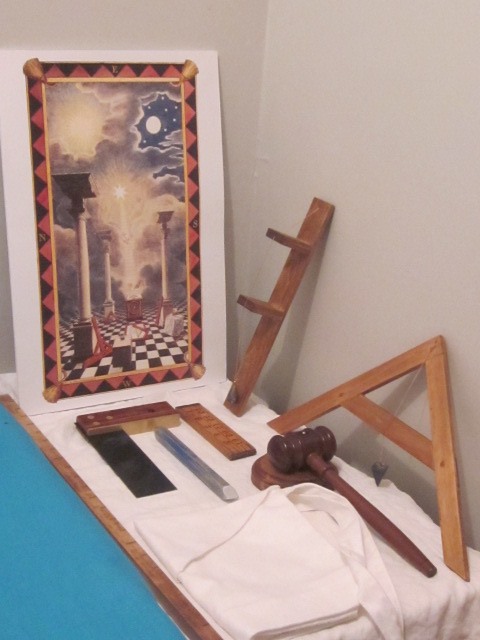
As far as I know, no one has written on the subject of self-initiation into Memphis Misraim. I am aware of precedents, such as Chic and Tabatha Cicero’s famous “Self-Initiation Into the Golden Dawn Tradition.” Therefore, this post opens discussion and is an invite for like-minded individuals who feel the same.
The Egyptian Rite of Memphis Misraim, aside from receiving a high rating on Pansophers.com, intrigues any occult student. For those new to this topic, Memphis Misraim (a.k.a “Egyptian Masonry”) is not your regular type masonry which solely focuses on the Judaic-Christian mythos maintained within the widespread English-Scottish forms of freemasonry, but instead in 1874, its first form, the Rite of Misraim, sought to reawaken the Hermetic and Egyptian mysteries within freemasonry. “All initiation comes from Egypt, all Light from the East,” is a statement from Cagliostro which set into motion a flurry of new masonic rituals which would embody the mysteries of the pharaohs, their priests, and the sun.
Setting itself apart from worldwide regular masonry, which typically has 33 degrees, Egyptian masonry has a whopping 90 degrees, even up to 99, depending on the branch you join. Much controversy has surrounded the rite, many colorful characters of occult history have been initiated into the rite, and many versions of the rite cannot agree on the true nature of its highest mystery. Largely, the final four degrees of the Egyptian Rite of Memphis Misraim, the 87th to the 90th, consist of the Arcana Arcanorum, a set of Hermetic degrees and alchemical practices which claim to hold the key to all masonry.
I, like many others, felt drawn to the rite and sought initiation into its sublime mysteries. But first, some personal history:
As a young craftsman in the 1970’s I found myself working on the restoration of Masonic “temple” in Wales. Apart from the local members, several of the older men with whom I worked were also Masons, and inevitably conversations opened up around the subject of Freemasonry. I became interested enough to read some of Gould’s History, which I found as dry as a bone, but also fortunate enough to come across the work of Manly P, Hall, which inspired me to question my older colleagues more closely. The responses I got in the main were not what I was hoping for. Beyond the understandable reticence, there seemed a genuine lack of knowledge, or even disinterest, in the more esoteric side of the Craft.
One of the men, with whom I worked, was a rather “different” sort of character. His name was George, and he was quiet, quirky, and a bit “stand-offish” from the others. One day I decided to open a conversation with him and he revealed that he was a Rosicrucian. His enthusiasm was obvious as he explained his own understanding of how the Rosicrucian movement had its roots in Ancient Egypt, and how that preceded Freemasonry. At the time I felt George was a true mystic, and that our encounter was of deep spiritual significance and it had opened me to further inquiry.
George must have left a lasting impression, since here I am writing this some 45 years later as a Rosicrucian myself. On several occasions through my mid-twenties I considered becoming a Mason; I was well situated insofar as I was self-employed and financially solvent with a drive for self- improvement. But something in me resisted the prospect of spending long hours sitting in opulent lodges and going through boring rituals. It seemed to me a rather sedentary club for well-to-do professional men and young social climbers. Besides, I was already an initiate of an esoteric order, meetings of which I attended weekly, as well as being a dedicated martial artist, having a full-time job and an active social life; so I already had enough going on.
Fast forward to 2018, and I came across an article by Sam Robinson on a rather obscure website, which referred to the Rite of Memphis Misraim as a gateway to the Rosicrucian current. Not long afterward I discovered the Pansophers blog and read Sam’s article on The Secret Origins of the AMORC Ritual Traditions. Needless to say, my interest was piqued, and I began to read everything I could find about the Ancient and Primitive Rite of Memphis Misraim.
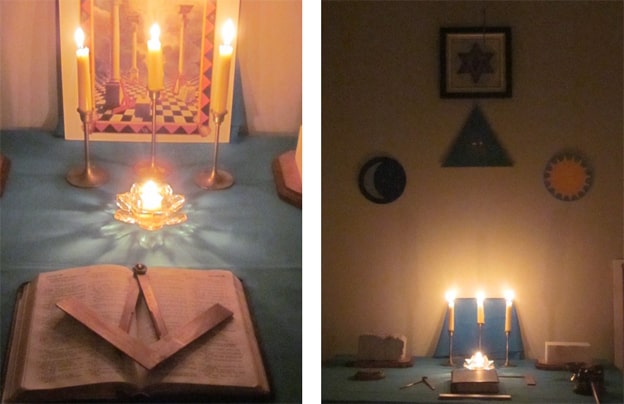
First degree opening and altar arrangement.
First off I ordered, read, and re-read Milko Bogard’s two excellent and informative books on the Egyptian Influence in Rosicrucianism and the MM Rite in particular. In the epilogue of the latter Sam encourages anyone who is sincerely interested in working the Rite to go ahead, if necessary independently – and to do it quietly and earnestly and well. I bracketed that advice for the time being and went about the business of finding a lodge in my area. On Google Search I found a plethora of Sovereign Sanctuaries, Grand Lodges and other groups invite enquiries and petitions by email.
Several of the groups never responded at all. One sent me a laconic response stating simply “You will be contacted” … one year later, still nothing. Another required a copy of my passport which felt to be an unreasonable request. Getting my hopes up, another offered me a date, time and place for my Entered Apprentice degree ritual, only to soon inform me that the planned initiations had been postponed indefinitely. At the time of writing once again I still await a simple acknowledgement from several groups for my tendered applications/petitions, some of which I submitted several times according to the tradition of giving “three knocks”. Needless to say, I began to feel more than a little frustrated by my lack of progress. Was I being given “the old run around” by the universe for a reason?
A recently published book on Esoteric Freemasonry by Jean Louis De Biasi caught my eye. I bought it because something in the review mentioned Egyptian Masonry, without realizing at the time that it was written partly with self-initiation in mind. As I read it, Sam’s words of encouragement came back to me, and I began to consider the prospect of “working” the Rite of MM on my own, as a personal journey, so to speak. If the Cicero’s had already opened the gates with their “Self-Initiation Into the Golden Dawn Tradition” then why is not the same possible for contacting the inner current of Egyptian Masonry? Certainly, I was personally familiar with self-initiation through my membership of a Rosicrucian order that allows this format as valid option for all but certain key degrees.
In the spring of 2019 I came to a decision…….. I would go ahead and begin the work independently and, as Sam put it: “get cracking”. Fortunately I had already established an oratory or “sanctum” in an obsolete archive storage space, which I readily equipped with the furnishings necessary for it to function as a “lodge”. I procured some pillars/pedestals in classic architectural styles, a checkered floor cloth, a tracing board, a rough and a smooth ashlar etc. all of course, on a relatively reduced scale. I began hand crafting some of the tools and implements (I borrowed this idea from the Golden Dawn tradition) and even hand-sewed my own apron. I set the date of my self-initiation to the degree of Entered Apprentice (EA) for June 24th – the feast of St John the Baptist, an auspicious day according to Masonic tradition.
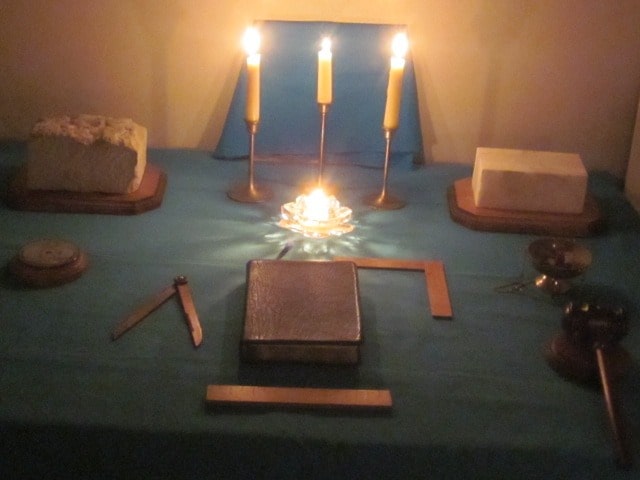
First degree altar arrangement.
By the time the day finally arrived, I had spent a couple of months reviewing the material in De Biasi’s book and learning more about the Egyptian Rite in general. It became evident that De Bias’s version of the Rite was somewhat divergent from others I had seen or read about. De Biasi is replete with invocations and devotional prayers to Egyptian deities, unlike other versions which were closer to Cagliostro’s original Rite. Because of my scant knowledge of Ancient Egyptian cultural and religious conventions, I decided to use De Biasis’s text as a basic framework, rather than a verbatum script for my ritual, relying on my conscience and intuition regarding omissions and substitutions. Thus the ritual became uniquely personalized, and something with which I was far more at ease, given my previous orientation toward more Solomonic rather than Kemetic material.
The final enactment of the ritual took about ninety minutes in total, and I recall experiencing moments of doubt about my own sanity as I undertook this enigmatic process, usually performed in a lodge with at least seven officers present, entirely alone. in a tiny back room in an empty building, but at least I could recognise certain similarities with my own Rosicrucian First Degree (which would make perfect sense). Afterwards I felt that I had at least taken a step in the right direction, and that now there was Work to be done. (I deliberately capitalize that word because I think it carries the implication of the Great Work when used in the context of this very alchemically biased Rite. In fact in a later communication with Sam, he reassured me that “it’s the work that counts”).
The Work of the entered Apprentice Degree was, for me, partly a matter of recognizing my own blind spots and prejudices with regard to the belief systems of the Ancient Egyptians; I read the Egyptian Book of the Dead. It was also about taking a long, hard look at my own egotistical and culturally biased beliefs about myself. I am not going to bore you, gentle reader, with an account of the emotional roller coaster that ensued, but I will say that at that point my life seemed to be being dismantled around me, and I entered a phase of abject internal desolation. (If I seem to be over-dramatizing this, believe me, I am not) Indeed, this was the blackness of Nigredo.
I read a lot, and I found Gregory B Stewart’s book, The Apprentice of most help. It is a rather oblique take on the Scottish Rite First Degree, with a definite leaning toward the mystical, including frequent references to kabbalah as it relates to Freemasonry.
Having set myself a six-month window to prepare for the Fellowcraft Degree, I also began to read ahead with regard to the ritual. At this point I contacted Sam, who was supportive and encouraging, asking me if I had written my own ritual; I felt the question itself was affirming of my efforts. I hadn’t yet, so drawing from the works of Albert Pike, Malcom Duncan and others I developed a comprehensive, syncritic ritual, hitting all of the “high spots” of the Scottish Rite Second degree, but with a distinctively Kemetic and alchemical flavor.
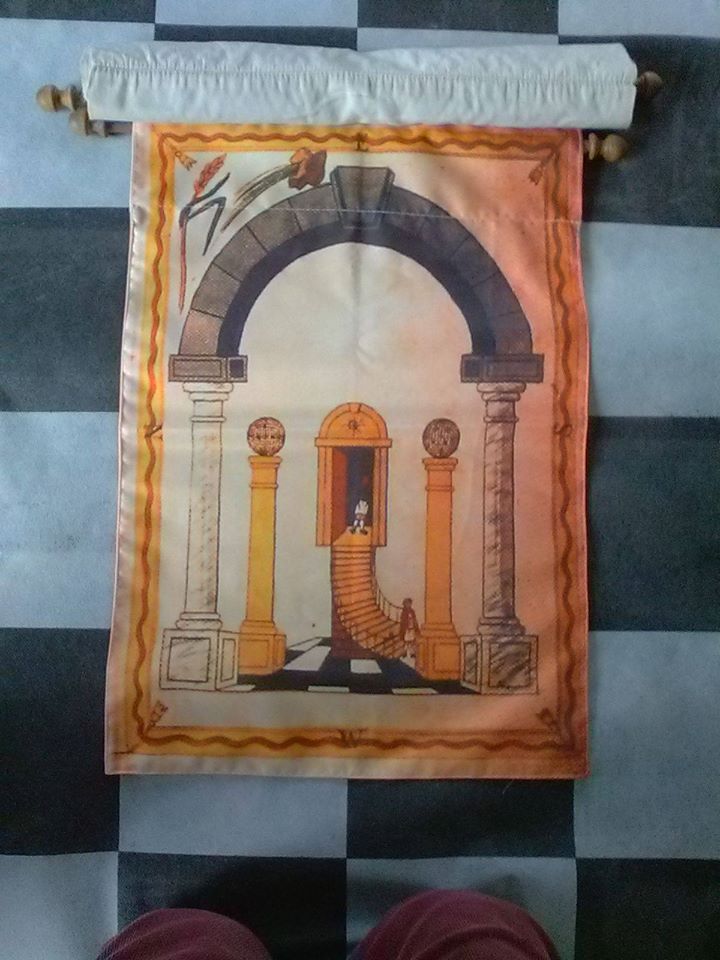
I planned for December 27th-the Feast of St John the Evangelist to undertake the ritual. The only problem was that it was so cumbersome, that when I came to perform it, the whole thing needed to be “serialized” into three one-hour sessions! Practically speaking, I discovered that I needed to move to a larger space to accommodate the Winding Staircase, which I had constructed from heavy card stock, and onto which I had painted the names of the attributes of Strength, Beauty and Wisdom, the Trivium, Quadruvium, and the Five Architectural Orders as an aide memoir. Another reason to move to a larger space was the utilization of a sword, as part of the ritual, although in the event I resorted to a poniard (a long, narrow dagger carried as a secondary weapon in renaissance times), since the only sword I own is a large, unwieldy Tai Chi Saber.
The Work of the Fellowcraft degree began with several readings and re-readings of Gregory B, Stewart’s Fellow of the Craft. Phillipa Faulks points out that in Cagliostro’s Rite, this grade emphasises the shift from the darkness and inertia of Nigredo to the dynamic and self-transformative phase of Albedo. De Biasi gives meditations and other exercises for all three Craft grades and I had been practicing these on a regular schedule since the beginning. One such exercise involves the intonation and visualization of Hebrew letters to be placed into various positions in the body, reminiscent of Kerning’s letter mysticism.
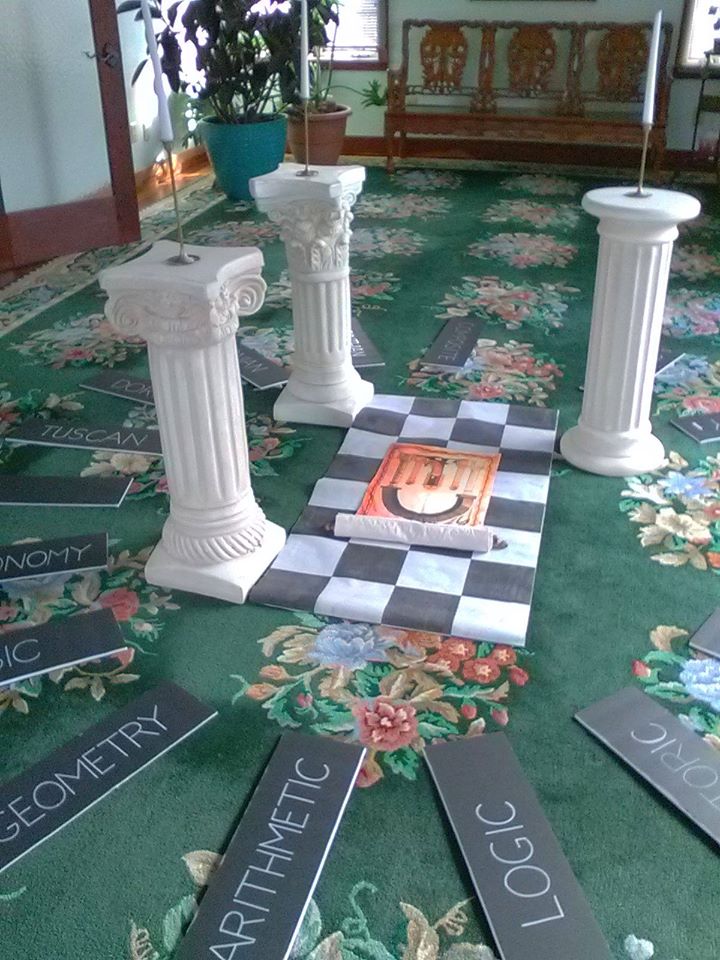
I continue with the Work of the Second Degree, and for me it is emphatically Work – with a capital “W”. I am still awaiting responses from several Grand Lodges or Sovereign Sanctuaries that I have sent petitions to, but I no longer feel so frustrated, since I am getting on with the Work in the meantime. In deeper conversation with Sam, he assured me that if I continue to proceed with authenticity and integrity, my efforts will attract attention from the right egregore.
At this the time of writing my next step I continue with the readings and the schedule of twice-monthly sessions of meditations and exercises in my “lodge” setting, and have set my intention to undertake the Master Mason Degree ritual on or around June 24th (St John’s Feast). By way of personal study I have read the Egyptian Book of the Dead from cover to cover; something that has been on my to-do list for 45 years.
As I write this I am only too aware that many Regular Masons and others may be thinking that I am deluded, and that there is no substitute for an initiation taken in a lodge, in the presence of the appointed officers and brethren. Of course I can only agree, and De Biasi himself states that there is no substitute for same. I would argue that although this is no substitute, it is an alternative, and one that allows for a personal journey into the esoteric aspects of Freemasonry where the Inner Work takes place. The other aspect of this process is the ways in which the insights and attributes acquired manifest through one’s attitudes, speech and actions in the world. As Manley P. Hall put it:
“A Mason is not necessarily a member of a lodge. In a broad sense, he (sic) is any person who daily tries to live the masonic life, and to serve intelligently the needs of the Great Architect”.
I will conclude by reminding myself and the reader of where I came in. Having come to understand that the Rite of Memphis Misraim is key to understanding the structure of many Rosicrucian and other esoteric organizations, I decided to explore the MM Rite through whatever means may be available and accessible to me. Presently it is the journey of a solitary traveler; but that does not mean that I would not welcome companionship along the way, or that a previously unseen door may not open into an established lodge. Who knows – one day that Secret Chief may actually show up…………
In the meantime I would like to invite anyone who may be interested in joining me on this journey to contact me by email.
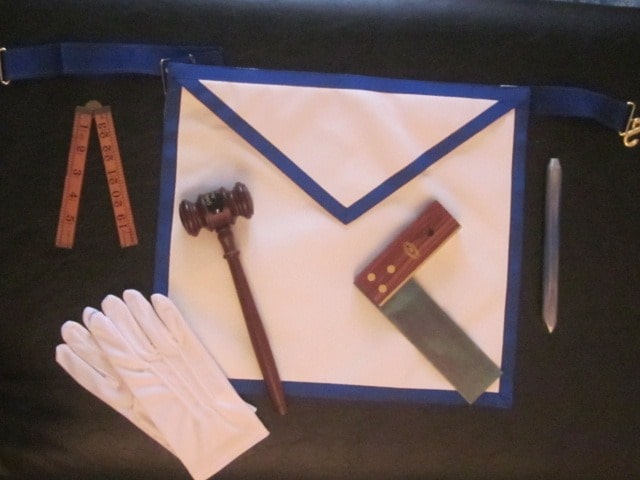
Second degree apron.
On behalf of the Pansophers.com team, thanks Graham for this great post! You certainly are not taking any half measures and the effort you’ve put into working the rite for yourself is impressive!

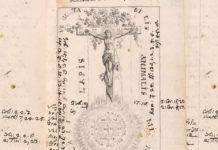

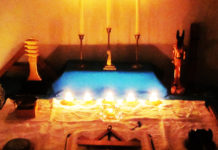







Brother! What a beautiful story. Such an inspiration.
What a fascinating journey and congratulations on being brave enough to take it without the “help” of a lodge or group.